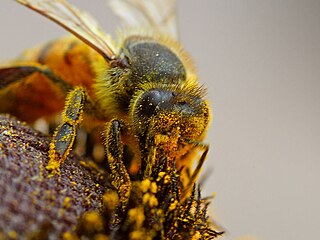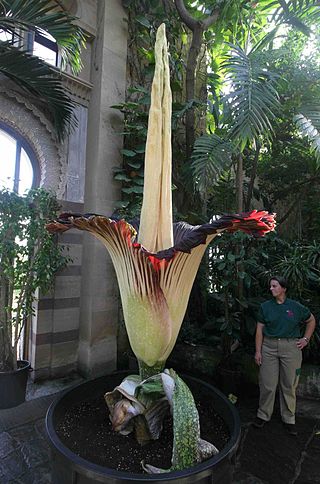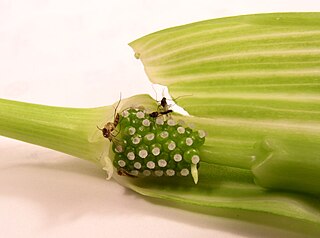
In angiosperms, a hypanthium or floral cup is a structure where basal portions of the calyx, the corolla, and the stamens form a cup-shaped tube. It is sometimes called a floral tube, a term that is also used for corolla tube and calyx tube. It often contains the nectaries of the plant. It is present in many plant families, although varies in structural dimensions and appearance. This differentiation between the hypanthium in particular species is useful for identification. Some geometric forms are obconic shapes as in toyon, whereas some are saucer-shaped as in Mitella caulescens.

A pollinator is an animal that moves pollen from the male anther of a flower to the female stigma of a flower. This helps to bring about fertilization of the ovules in the flower by the male gametes from the pollen grains.

Petals are modified leaves that surround the reproductive parts of flowers. They are often brightly colored or unusually shaped to attract pollinators. All of the petals of a flower are collectively known as the corolla. Petals are usually accompanied by another set of modified leaves called sepals, that collectively form the calyx and lie just beneath the corolla. The calyx and the corolla together make up the perianth, the non-reproductive portion of a flower. When the petals and sepals of a flower are difficult to distinguish, they are collectively called tepals. Examples of plants in which the term tepal is appropriate include genera such as Aloe and Tulipa. Conversely, genera such as Rosa and Phaseolus have well-distinguished sepals and petals. When the undifferentiated tepals resemble petals, they are referred to as "petaloid", as in petaloid monocots, orders of monocots with brightly colored tepals. Since they include Liliales, an alternative name is lilioid monocots.

Hoverflies, also called flower flies or syrphids, make up the insect family Syrphidae. As their common name suggests, they are often seen hovering or nectaring at flowers; the adults of many species feed mainly on nectar and pollen, while the larvae (maggots) eat a wide range of foods. In some species, the larvae are saprotrophs, eating decaying plant and animal matter in the soil or in ponds and streams. In other species, the larvae are insectivores and prey on aphids, thrips, and other plant-sucking insects.

Pollination is the transfer of pollen from an anther of a plant to the stigma of a plant, later enabling fertilisation and the production of seeds, most often by an animal or by wind. Pollinating agents can be animals such as insects, for example beetles; birds, butterflies, and bats; water; wind; and even plants themselves. Pollinating animals travel from plant to plant carrying pollen on their bodies in a vital interaction that allows the transfer of genetic material critical to the reproductive system of most flowering plants. When self-pollination occurs within a closed flower. Pollination often occurs within a species. When pollination occurs between species, it can produce hybrid offspring in nature and in plant breeding work.

Philodendron is a large genus of flowering plants in the family Araceae. As of September 2015, the World Checklist of Selected Plant Families accepted 489 species; other sources accept different numbers. Regardless of number of species, the genus is the second-largest member of the family Araceae, after genus Anthurium. Taxonomically, the genus Philodendron is still poorly known, with many undescribed species. Many are grown as ornamental and indoor plants. The name derives from the Greek words philo- 'love, affection' and dendron 'tree'. The generic name, Philodendron, is often used as the English name.

Entomophily or insect pollination is a form of pollination whereby pollen of plants, especially but not only of flowering plants, is distributed by insects. Flowers pollinated by insects typically advertise themselves with bright colours, sometimes with conspicuous patterns leading to rewards of pollen and nectar; they may also have an attractive scent which in some cases mimics insect pheromones. Insect pollinators such as bees have adaptations for their role, such as lapping or sucking mouthparts to take in nectar, and in some species also pollen baskets on their hind legs. This required the coevolution of insects and flowering plants in the development of pollination behaviour by the insects and pollination mechanisms by the flowers, benefiting both groups. Both the size and the density of a population are known to affect pollination and subsequent reproductive performance.

Carrion flowers, also known as corpse flowers or stinking flowers, are mimetic flowers that emit an odor that smells like rotting flesh. Apart from the scent, carrion flowers often display additional characteristics that contribute to the mimesis of a decaying corpse. These include their specific coloration, the presence of setae and orifice-like flower architecture. Carrion flowers attract mostly scavenging flies and beetles as pollinators. Some species may trap the insects temporarily to ensure the gathering and transfer of pollen.

Nectar is a sugar-rich liquid produced by plants in glands called nectaries or nectarines, either within the flowers with which it attracts pollinating animals, or by extrafloral nectaries, which provide a nutrient source to animal mutualists, which in turn provide herbivore protection. Common nectar-consuming pollinators include mosquitoes, hoverflies, wasps, bees, butterflies and moths, hummingbirds, honeyeaters and bats. Nectar plays a crucial role in the foraging economics and evolution of nectar-eating species; for example, nectar foraging behavior is largely responsible for the divergent evolution of the African honey bee, A. m. scutellata and the western honey bee.

A flower, also known as a bloom or blossom, is the reproductive structure found in flowering plants. Flowers consist of a combination of vegetative organs – sepals that enclose and protect the developing flower, petals that attract pollinators, and reproductive organs that produce gametophytes, which in flowering plants produce gametes. The male gametophytes, which produce sperm, are enclosed within pollen grains produced in the anthers. The female gametophytes are contained within the ovules produced in the carpels.

In zoology, a nectarivore is an animal which derives its energy and nutrient requirements from a diet consisting mainly or exclusively of the sugar-rich nectar produced by flowering plants.

Ornithophily or bird pollination is the pollination of flowering plants by birds. This sometimes coevolutionary association is derived from insect pollination (entomophily) and is particularly well developed in some parts of the world, especially in the tropics, Southern Africa, and on some island chains. The association involves several distinctive plant adaptations forming a "pollination syndrome". The plants typically have colourful, often red, flowers with long tubular structures holding ample nectar and orientations of the stamen and stigma that ensure contact with the pollinator. Birds involved in ornithophily tend to be specialist nectarivores with brushy tongues and long bills, that are either capable of hovering flight or light enough to perch on the flower structures.

In zoology, a palynivore /pəˈlɪnəvɔːɹ/, meaning "pollen eater" is an herbivorous animal which selectively eats the nutrient-rich pollen produced by angiosperms and gymnosperms. Most true palynivores are insects or mites. The category in its strictest application includes most bees, and a few kinds of wasps, as pollen is often the only solid food consumed by all life stages in these insects. However, the category can be extended to include more diverse species. For example, palynivorous mites and thrips typically feed on the liquid content of the pollen grains without actually consuming the exine, or the solid portion of the grain. Additionally, the list is expanded greatly if one takes into consideration species where either the larval or adult stage feeds on pollen, but not both. There are other wasps which are in this category, as well as many beetles, flies, butterflies, and moths. One such example of a bee species that only consumes pollen in its larval stage is the Apis mellifera carnica. There is a vast array of insects that will feed opportunistically on pollen, as will various birds, orb-weaving spiders and other nectarivores.

Pollination syndromes are suites of flower traits that have evolved in response to natural selection imposed by different pollen vectors, which can be abiotic or biotic, such as birds, bees, flies, and so forth through a process called pollinator-mediated selection. These traits include flower shape, size, colour, odour, reward type and amount, nectar composition, timing of flowering, etc. For example, tubular red flowers with copious nectar often attract birds; foul smelling flowers attract carrion flies or beetles, etc.

Nectar robbing is a foraging behavior utilized by some organisms that feed on floral nectar, carried out by feeding from holes bitten in flowers, rather than by entering through the flowers' natural openings. "Nectar robbers" usually feed in this way, avoiding contact with the floral reproductive structures, and therefore do not facilitate plant reproduction via pollination. Because many species that act as pollinators also act as nectar robbers, nectar robbing is considered to be a form of exploitation of plant-pollinator mutualism. While there is variation in the dependency on nectar for robber species, most species rob facultatively.

Pollination traps or trap-flowers are plant flower structures that aid the trapping of insects, mainly flies, so as to enhance their effectiveness in pollination. The structures of pollination traps can include deep tubular corollas with downward pointing hairs, slippery surfaces, adhesive liquid, attractants, flower closing and other mechanisms.

The monocots are one of the two major groups of flowering plants, the other being the dicots. In order to reproduce they utilize various strategies such as employing forms of asexual reproduction, restricting which individuals they are sexually compatible with, or influencing how they are pollinated. Nearly all reproductive strategies that evolved in the dicots have independently evolved in monocots as well. Despite these similarities and their close relatedness, monocots and dicots have distinct traits in their reproductive biologies.

The pollination of orchids is a complex chapter in the biology of this family of plants that are distinguished by the complexity of their flowers and by intricate ecological interactions with their pollinator agents. It has captured the attention of numerous scientists over time, including Charles Darwin, father of the theory of evolution by natural selection. Darwin published in 1862 the first observations of the fundamental role of insects in orchid pollination, in his book The Fertilization of Orchids. Darwin stated that the varied stratagems orchids use to attract their pollinators transcend the imagination of any human being.

A pollinator garden is a type of garden designed with the intent of growing specific nectar and pollen-producing plants, in a way that attracts pollinating insects known as pollinators. Pollinators aid in the production of one out of every three bites of food consumed by humans, and pollinator gardens are a way to offer support for these species. In order for a garden to be considered a pollinator garden, it should provide various nectar producing flowers, shelter or shelter-providing plants for pollinators, and avoid the use of pesticides.

UV coloration is a natural phenomenon that leads to unique interactions between organisms that have evolved the ability to perceive these wavelengths of light. It serves as one method to attract pollinators to the flower along with scent, shape, and nectar quality. Flowers are known for their range of visible colors that humans can see with their eyes and observe an array of different shades and patterns. The naked eye cannot see the ultraviolet coloration many flowers employ to bring attention to themselves. By either reflecting or absorbing UV light waves, flowers are able to communicate with pollinators. This allows plants that may require an animal pollinator to stand out from other flowers or distinguish where their flowers are in a muddied background of other plant parts. For the plant, it is important to share and receive pollen so they can reproduce, maintain their ecological role, and guide the evolutionary history of the population.





















